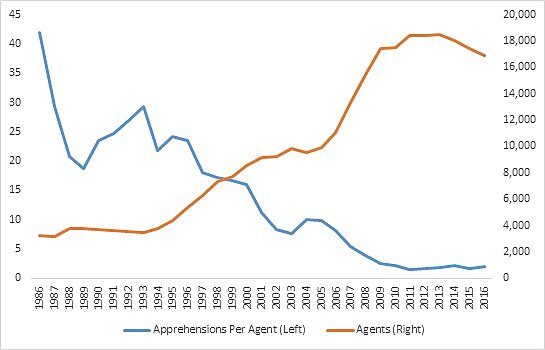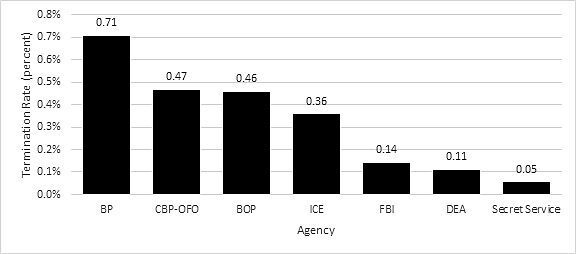The main argument against President Trump’s plan to hire more Border Patrol agents is that the Southern border does not need them. Even border hawks can’t argue with the evidence that Border Patrol agents are a lot less busy than they used to be. In 1986, Border Patrol agents along the Southern border apprehended an average of 42 illegal immigrants every month. That number fell to 2 a month by 2016 – one apprehension for every couple of weeks on the job (Figure 1). The last month that apprehensions for all Border Patrol were above three per agent was in April 2010 and the number has steadily declined since then. From January through September 2017, all Border Patrol agents have apprehended an average of 1.1 illegal crossers per month. Even if you believe that the hiring spree of Border Patrol agents in recent decades stopped unlawful immigration (probably not), there is no good reason to hire more unionized government law enforcement officers to patrol a secure border.
Figure 1
Apprehensions Per Border Patrol Agent
Source: Customs and Border Protection.
Another good reason not to expand an expensive federal law enforcement agency that already has too little to do is that there are serious personnel and, likely, corruption issues in Border Patrol that need to be addressed first. My recent Cato Institute Policy Analysis delved into the opaque world of corruption data in Customs and Border Protection (CBP) and found lots of poorly reported and contradictory information. Fortunately, the Office of Personnel Management (OPM) does report the number of terminations by reason per occupation per agency. Although OPM doesn’t specifically identify corruption, a termination for discipline or performance includes those terminated for corruption – as well as other issues. The results were worse than I suspected: Border Patrol agents were the most likely to be terminated for poor discipline and bad performance than law enforcement officers in any other large federal law enforcement agency (Figure 2). The second most likely to be terminated were Customs Officers. Immigration and Customs Enforcement (ICE) agents were the fourth most likely.
Figure 2
Termination Rate for Law Enforcement Officers by Federal Agency, 2006–2016
Sources: Office of Personnel Management, “FedScope Separations Cube, Fiscal 2006–2016”; and Office of Personnel Management, “FedScope Employment Cube, Fiscal Years 2006–2016.” Published in “Border Patrol Termination Rates: Discipline and Performance Problems Signal Need for Reform,” Cato Institute Policy Analysis, November 2, 2017.
Note: BOP = Bureau of Prisons; BP = Border Patrol; CBP-OFO = Customs and Border Protection Office of Field Operations; DEA = Drug Enforcement Administration; FBI = Federal Bureau of Investigation; ICE = Immigration and Customs Enforcement.
All in all, Border Patrol agents were twice as likely to be terminated for disciplinary infractions or poor performance as ICE agents and 49 percent more likely than CBP officers who work in the Office of Field Operations, from 2006 through 2016. Border Patrol agents were 54 percent more likely than guards at the Bureau of Prisons to be terminated for disciplinary infractions or poor performance, 6 times as likely as Federal Bureau of Investigation agents, 7.1 times as likely as Drug Enforcement Administration agents, and 12.9 times as likely as Secret Service agents.
The lack of effective internal affairs at Border Patrol and CBP is a major reason for these problems. There is some positive movement on Capitol Hill to address the lack of sufficient internal affairs at Border Patrol and CBP, but it is unfortunately tied to a massive and unnecessary expansion of the force itself. Severe discipline and performance problems combined with a historic slowdown in the number of illegal immigrant border crossers are two excellent reasons not to hire 5,000 additional Border Patrol agents.


